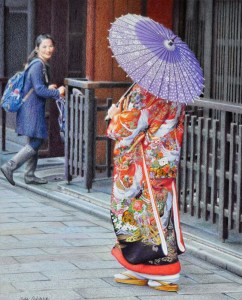In my second year of art school back in 1978, we students were given the task of painting a still life of our choice. I chose to realistically paint my (then) boyfriend’s air rifle. It must have been the various textures which interested me; glossy wood and black metal. The object was displayed on my desk. I studied it over several days, meticulously rendering every detail in oil paint. It was only when I had finished painting the air rifle that I asked myself the question, “What shall I do about the background?”
At that point the painting was doomed. I had not planned the painting through to its conclusion at conception. I had only thought of the main subject in isolation without considering its immediate environment. When I tried to paint in the surroundings as an afterthought, everything fell to bits. It was a good lesson though – and 37 years later I remember it like yesterday: Don’t make the background an afterthought!
The topic of backgrounds comes up quite often in art groups which I belong to. Now and then a person laments that he or she is not keen on backgrounds or is no good at them. The person wants to get straight to the main subject – relegating the background to something to be “gotten through” – a nuisance even. Just the other day I saw a beautifully drawn flower in one of these groups. The artist had done a lovely job but asked on Facebook, “Now, how am I going to do the background?” (Alarm bells!)
There may be a belief that a background is less important than the subject within it. I prefer to think that the subject and its surrounds are equally valuable and that they support one another. The composition is one integrated whole. Imagine a composer writing a concerto for violin and orchestra. He has completed the score for the solo instrument and thinks to himself, “I am completely satisfied with what I’ve written for the violin. Now, what am I going to do with the orchestra?” No way. You, the visual artist, are just like the musical composer. Plan your composition from the outset.

No part of the drawing is less important than another part.
Of course, I am not suggesting that every space on a page needs to be filled with pigment. A work with NO background is complete if that is the artist’s intention. Just as there can be a sonata for a single instrument or an actor’s soliloquy on a stage without props, so can there be a floating object on white paper. Nor do you necessarily know how you are going to tackle various parts of your composition from the outset. There have to be some surprises and experimenting as you go. For example, fellow CPSA member, Sharon Kow (Malaysia) “discovered” pointillism for herself while she was figuring out how to render the texture of concrete in pencils.
A background describes the story you are telling. It gives the subject its roots; its sense of time and place, history and meaning. It is the subject’s environment; the air it breathes, the terra firma it stands on or water it is suspended in. It radiates light or lurks in shadow. Each background is its own evocative world. We should relish our backgrounds, knowing that they are places which give our subjects their life.

Coloured pencils and Neopastels, 2015
What a joy to create a poetic space on paper where one’s subject thrives. Background and subject support one another in a symbiotic fashion, each sustaining and strengthening the other.


Hi Julie, I completely agree with your philosophy on backgrounds – esp. the virtue of having no background. In Traditional Chinese Painting which I have been doing for many years besides western watercolours, the unpainted spaces are just as important as the painted image itself , and consideration must be given to the shape, size and balance of the parts left white.
I understand, Philomena. Becoming interested in Japanese aestheticism has made me more aware and appreciative of space around an object as opposed to crowding it in. Less is more. If one is shown too much, then one sees nothing at all.
Your comments may explain my feeling that many of the beautiful renderings I see on social media leave me wanting. The beauty is there or the wow factor is there but the story is missing. You have given me much to think about.
Hi Pamela, thanks for your feedback. I love it that my words have given you much to think about. If you come to any conclusions let me know. I’m sure I have way more questions than answers myself!